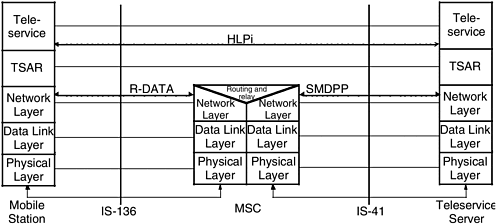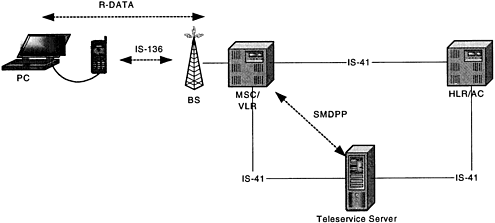5.4 IS-136 Teleservices
5.4 IS-136 TeleservicesIS-136 teleservices are a feature of IS-136 networks that have been developed to speed up the introduction of new services for IS-136 users. A teleservice is an application that uses the air interface and network interface as the bearers for transport between a server and a mobile station. In other words, a teleservice uses the mobile station connection through the cellular network as a "bit-pipe" to exchange information with the mobile station. Teleservices allow service providers to deliver data units to mobile stations that are connected using either DCCH or DTC. Teleservices are possible both when the user is roaming or in the home network. The data units can contain data for user applications or programming information for the mobile station. Teleservices can be either point-to-point or broadcast. The following teleservices have been defined and standardized for IS-136:
5.4.1 Teleservice DeliveryA teleservice is provided above the layer 3 of IS-136 (i.e., it is an application encapsulated in layer 3 messages called R-DATA). IS-41 defines a similar message called short message delivery point-to-point (SMDPP) to carry information for teleservices. A higher protocol layer identifier (HLPI) is used to identify the type of teleservice to the mobile station, whereas a teleservice ID identifies it to servers. Figure 5-6 depicts the protocol stack for teleservices. Figure 5-6. Protocol stack for teleservices. For most teleservices, the cellular network takes SMDPP messages received from a server and reformats the content for transmission to the mobile station using R-DATA messages without the need to read or understand the content of SMDPP or R-DATA messages (see Figure 5-7). Teleservices can also be provided over the Teleservice Segmentation and Reassembly (TSAR) protocol defined by IS-136-A, or over the broadcast teleservice transport function. Figure 5-7. Architecture of IS-136 teleservice delivery. Broadcast teleservices are delivered to mobile stations differently. Broadcast teleservices transport allows an efficient way of delivering broadcast teleservices to groups of mobile stations if the same information is of interest of more mobile stations. It allows one to define a zone within a cellular network and to differentiate the services provided in each zone. The transport allows also one to classify broadcast teleservices into categories and service groups and to provide additional information to mobile stations to allow them to discriminate more efficiently between broadcast teleservices to read and broadcast teleservices to disregard. This additional information may indicate to mobile stations what broadcast teleservices are available in the zone where the mobile station is currently located and what channels deliver them. Figure 5-8 describes transport of broadcast teleservices. When a broadcast teleservices server generates broadcast teleservices information and forwards it to MSCs in SMDPP frames , it includes broadcast teleservice transport information to identify how the broadcast teleservice information is to be distributed. Each receiving MSC uses the broadcast teleservice transport information to determine which cluster of BSs (i.e., which zone) the broadcast teleservice information needs to be delivered to. Figure 5-8. Broadcast teleservice delivery. |
EAN: 2147483647
Pages: 164


